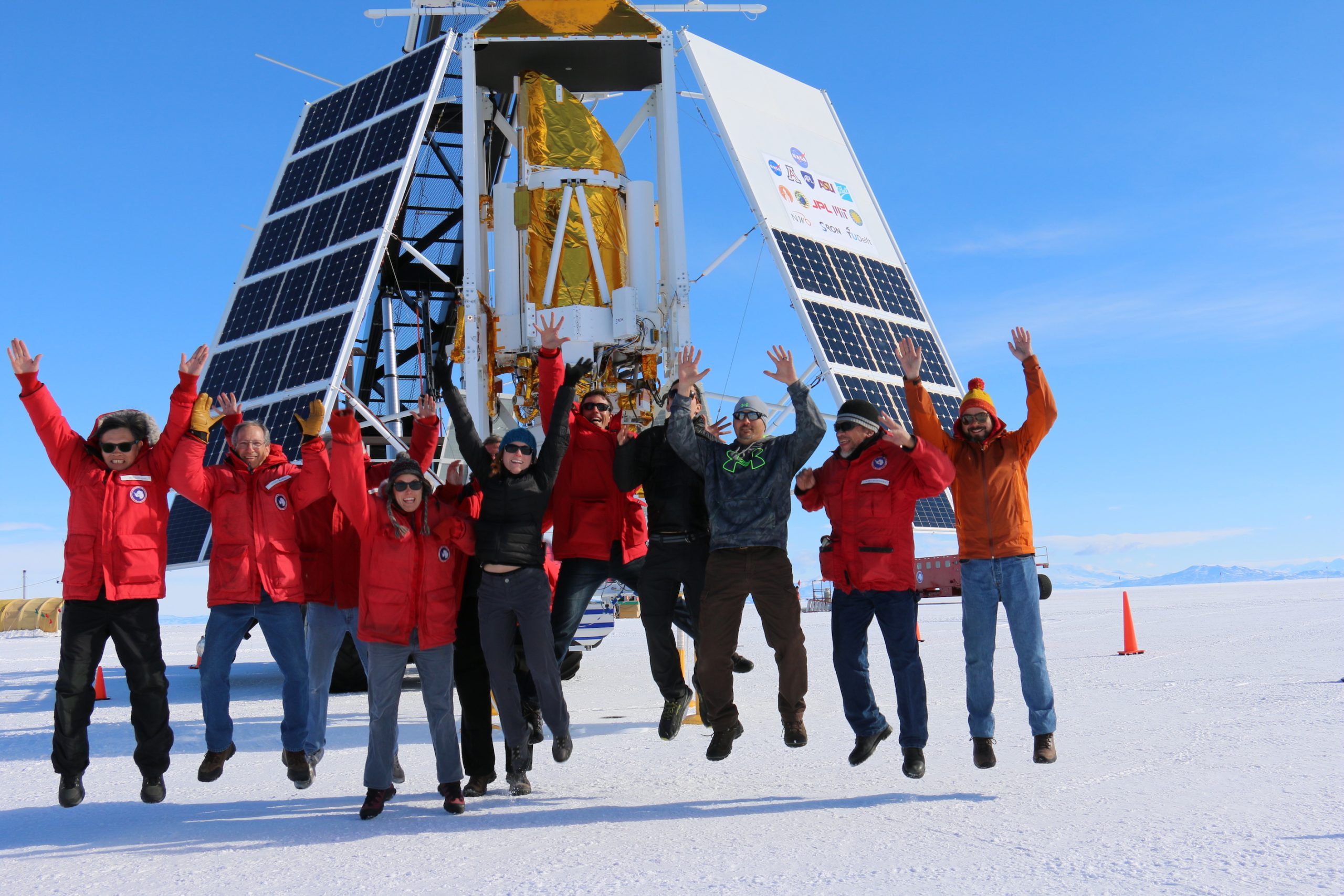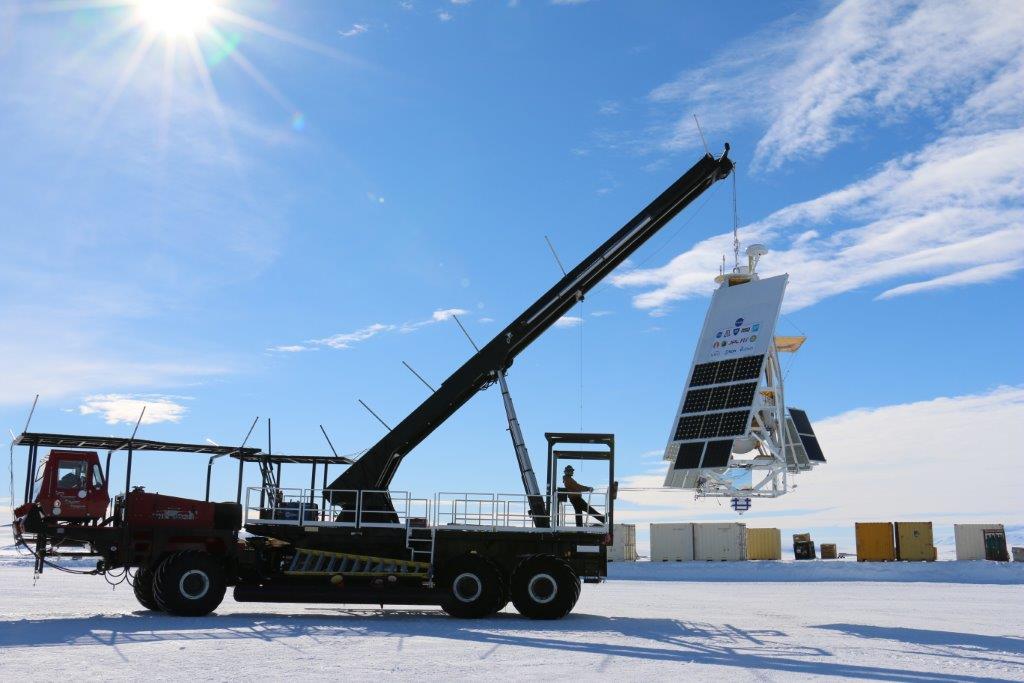Vorig jaar bleef hij door slechte weersomstandigheden aan de grond, maar nu gaat hij als het goed is wel de lucht in: de telescoop STO2, die onder een enorme NASA-ballon op 40 km boven Antarctica twee weken lang waarnemingen moet gaan doen aan moleculaire wolken in het heelal, de geboorteplaats van sterren. Donderdagavond 19.00 uur Nederlandse tijd (vrijdagochtend op Antarctica) staat de lancering gepland. SRON en TU Delft bouwden de sensoren in het hart van de telescoop. (English follows Dutch)

Sterren en planeten worden geboren uit wolken van moleculen die samenklonteren en uiteindelijk weer uiteenvallen in de ruimte tussen de sterren in een melkwegstelsel. Astronomen weten nog niet precies hoe dit werkt.
NASA’s stratosfeerballon STO2 stijgt daarom vanaf Antarctica op, tot aan de rand van de ruimte, om daar ver-infraroodstraling uit het heelal te meten.
Op een hoogte van 40 kilometer boven Antarctica is de lucht kristalhelder. Er is nauwelijks waterdamp, die op andere plekken in de atmosfeer dit soort straling juist vaak blokkeert.
De NASA-ballonnen die meetinstrumenten naar die hoogte brengen, maken gebruik van de circulaire poolwind (polar vortex), een stabiele luchtstroom waarop de ballon een of meer rondes van elk zo’n 14 dagen mee circuleert. Zo kunnen wetenschappers twee weken lang waarnemingen doen en zien ze daarna de ballon bijna op dezelfde plek weer terug.
Eindelijk ongehinderd zicht op verklikker sterrenkraamkamers
STO2 bevat sensoren van SRON Netherlands Institute for Space Research (Utrecht en Groningen) en de TU Delft. Het gaat om drie ontvangers voor respectievelijk 1,4 1,9 en 4,7 TeraHertz.
De spectra van straling op die frequenties verraden de aanwezigheid van elementen in de ruimte waaronder ook elektrisch neutraal atomair zuurstof. Het lokaliseren van dat laatste element in de ruimte, door de 4,7 TeraHertz ontvanger, is een lang gekoesterde droom van astronomen.
Er is nog niet eerder een 4,7 TeraHertz ontvanger naar de ruimterand gebracht voor onbelemmerd zicht. Een referentiebron voor straling met deze frequentie ontwikkelden de partners samen met het Massachusetts Institute of Technology (MIT).
Elektrisch neutraal atomair zuurstof vertelt ons welke plekken in de gaswolken tussen de sterren bijzonder warm zijn, wat een goede indicatie is voor pasgevormde sterren. We kunnen zo dus de kraamkamers van nieuwe sterren direct opsporen.
STO2 is dan ook een belangrijke verkenner voor toekomstige TeraHertz missies in de ruimte met een satelliet.
Ver-infraroodstraling wordt ook wel TeraHertz straling genoemd. 1 THz Komt overeen met 300 micrometer golflengte.
De wetenschappelijke leiding van de missie is in handen van de Universiteit van Arizona. De universiteit verkoos de Nederlandse detectoren boven andere kandidaten uit eigen land. De teams van prof. dr. Alexander Tielens (Universiteit Leiden) en prof. dr. Floris van der Tak (SRON/Rijksuniversiteit Groningen) dragen straks bij aan de internationale wetenschappelijke analyse van de waarnemingen.
Donderdag vanaf 19.00 uur Nederlandse tijd zijn de weersomstandigheden drie uur lang gunstig voor lancering. Lukt het daarbinnen niet, dan volgen in de dagen erna nieuwe kansrijke ‘lanceervensters’ qua weer. De missie zal te volgen zijn via een livestream van de NASA. http://www.ustream.tv/channel/nasa-csbf-ldsd.
Looking at the evolution of stars
Polar balloon STO2 to go the edge of space with Dutch instruments
Last year it stayed on the ground due to bad weather conditions, but this year it will fly: the STO2 telescope, that will peer into molecular clouds in the universe where stars are born, while hanging on a giant NASA balloon, 40 kilometers above Antarctica. The launch is now scheduled for thursday December 8th, 7 PM CET, which is fridaymorning on Antarctica. SRON and TUDelft built the sensors in the telescope’s heart.

Stars and planets are born from clouds of molecules that coagulate and eventually fall apart again in the space between the stars in a galaxy. Astronomers still do not know exactly how this works. That is why NASA’s stratospheric balloon STO2 will be launched from Antarctica to the edge of space to measure cosmic far infrared radiation.
At an altitude of 40 kilometers above Antarctica, the air is crystal clear. There is scarcely any water vapor, which often blocks this type of radiation at other locations in the atmosphere.
The NASA balloon that will carry the measuring instruments to this altitude will make use of the circular polar vortex, a stable airflow on which the balloon can circulate with for one or more rounds of about 14 days each. This will allow scientists to carry out observations for a period of two weeks before they find the balloon at nearly the same location again.
STO2 has been developed under the leadership of the University of Arizona and contains vital contributions from SRON Netherlands Institute for Space Research (Utrecht and Groningen) and tech university TUDelft. These are three receivers for 1.4, 1.9 and 4.7 terahertz respectively.
Spectra of radiation at these frequencies often disclose the presence of elements in space, including electrically neutral atomic oxygen. The localization of that last element in space, which can be achieved using the 4.7 terahertz receiver, is a long-cherished dream of astronomers. It is the first time a 4.7 terahertz receiver will be brought to the edge of space for an unrestricted view. Together with the Massachusetts Institute of Technology (MIT), the partners developed a reference source for radiation at this frequency.
Electrically neutral atomic oxygen reveals us places in the gas clouds between stars that are particularly warm. This is a good indicator for stars that only just formed. This way we can directly find the birthplaces of new stars. STO2 is therefore an important scouting mission for future terahertz missions using a satellite in space. Far infrared radiation is sometimes also referred to as terahertz radiation. One terahertz is equivalent to a wavelength of 300 micrometers.
The University of Arizona is scientifically in the lead of the mission. The teams of prof. dr. Alexander Tielens (Universiteit Leiden) and prof. dr. Floris van der Tak (SRON/Rijksuniversiteit Groningen) will help in the international scientific analysis of the observations.
Thursday the team on Antarctica gets three hours of good weather conditions. If this is too short, nice launching weather will follow in the following days. A livestream of the mission from NASA:
http://www.ustream.tv/channel/nasa-csbf-ldsd
.


